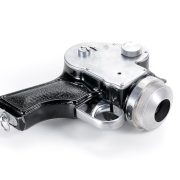Photography has evolved rapidly over the years, moving from film to digital and now into the world of flexible, high-performance devices. One of the most exciting innovations in modern photography is the ILC camera. ILC stands for Interchangeable Lens Camera, and as the name suggests, it allows you to change lenses based on your needs and creative goals. Whether you are a beginner trying to take better photos or an aspiring professional, understanding what an ILC camera is and how it works can completely change the way you capture the world.
What Does ILC Mean
An ILC, or Interchangeable Lens Camera, is a type of digital camera that gives you the ability to swap out lenses. Unlike compact or point-and-shoot cameras that have built-in lenses, an ILC provides the flexibility to attach different lenses for various styles of photography. You can use a wide-angle lens for landscapes, a telephoto lens for wildlife, or a macro lens for detailed close-up shots.
This versatility is what makes ILCs so popular among photographers. The ability to adapt your gear to the situation helps produce higher-quality images and gives you complete creative control over your photography style.
Types of ILC Cameras
There are two main types of ILC cameras: DSLR and Mirrorless.
DSLR Cameras (Digital Single-Lens Reflex):
These are the traditional type of ILC cameras. They use a mirror and optical viewfinder system that reflects light from the lens up into the viewfinder. DSLRs are known for durability, long battery life, and a wide range of compatible lenses.
Mirrorless Cameras:
Mirrorless ILCs, as the name suggests, do not use a mirror system. Instead, they rely on digital displays and electronic viewfinders to show the image directly from the sensor. Mirrorless cameras are generally smaller, lighter, and faster at capturing images in live view or video mode.
Both types offer outstanding quality, but mirrorless cameras have become the preferred choice for many photographers due to their compact design and advanced technology.
How ILC Cameras Work
The working principle of an ILC camera revolves around its interchangeable lens mount and image sensor. When you attach a lens, it directs light through the aperture and onto the camera’s sensor, where the image is recorded.
What makes ILCs different is that you can change the lens to modify the field of view, depth of field, and focal length. This gives you far greater control over how your photos look compared to smartphones or compact cameras.
ILCs also come equipped with manual controls that allow you to adjust shutter speed, ISO, and aperture — three key elements that influence exposure and image quality. Together, these features let you create professional-grade photos in virtually any environment.
Benefits of Using an ILC Camera
There are many advantages to using an interchangeable lens camera over standard fixed-lens models.
Image Quality:
ILCs feature larger sensors than those found in compact cameras or smartphones, resulting in sharper images, better color accuracy, and improved low-light performance.
Lens Flexibility:
You can switch between different lenses for various shooting situations — from wide landscapes to close-up portraits.
Creative Control:
Manual settings allow you to experiment with exposure, focus, and lighting. You can shoot in RAW format for maximum editing flexibility.
Durability and Longevity:
ILC cameras are built to last, often with weather sealing and robust bodies designed for professional use.
Upgrade Potential:
As technology evolves, you can upgrade lenses or accessories without replacing the entire camera system.
These benefits make ILCs an excellent investment for beginners who want to grow their photography skills over time.
ILC Cameras vs Point-and-Shoot Cameras
A major difference between an ILC and a point-and-shoot camera lies in flexibility and performance. Point-and-shoot cameras are designed for convenience. They have built-in lenses and automatic settings that make them easy to use, but they lack the advanced features and customization of an ILC.
ILCs, on the other hand, offer much greater versatility. You can fine-tune every setting, attach different lenses, and use external accessories like flashes or microphones. While they may require a learning curve, the creative possibilities are endless.
In short, a point-and-shoot camera is ideal for casual users, while an ILC is perfect for anyone serious about learning photography or seeking higher image quality.
Common Features Found in ILC Cameras
Modern ILC cameras come packed with advanced features that cater to both beginners and professionals. Some of the most common include:
Manual and Automatic Modes: You can choose between full control or automatic settings, depending on your comfort level.
High-Resolution Sensors: Most ILCs feature sensors ranging from 16MP to over 60MP, offering exceptional detail.
Fast Autofocus Systems: Mirrorless cameras especially excel at rapid and accurate autofocus, useful for capturing action or wildlife.
Interchangeable Lenses: The ability to use a variety of lenses is the core feature of ILC cameras.
4K or Higher Video Recording: Many ILCs double as powerful video cameras with advanced stabilization and focus tracking.
Wi-Fi and Bluetooth Connectivity: These allow for easy file transfers and remote control from smartphones.
These features ensure that an ILC can handle nearly any shooting scenario, from casual photos to cinematic video production.
Choosing the Right ILC Camera for Beginners
Selecting your first ILC camera can feel overwhelming because there are so many options on the market. Start by considering the following factors:
- Budget: Decide how much you are willing to spend. Entry-level mirrorless cameras start around a few hundred dollars, while professional models can cost several thousand.
- Purpose: Think about what you want to photograph. Travel, portraits, sports, or nature photography may require different lenses and body types.
- Ease of Use: Beginners should look for cameras with intuitive controls, touchscreen interfaces, and built-in tutorials.
- Lens Compatibility: Check which lenses are available for your chosen brand. Popular systems include Canon RF, Sony E-mount, and Nikon Z-mount.
- Portability: If you travel often, a compact mirrorless camera might suit you better than a bulkier DSLR.
By evaluating these factors, you can find a model that balances performance, cost, and convenience.
Tips for Getting Started with an ILC Camera
Once you have your first ILC camera, learning how to use it effectively will make all the difference. Here are some practical tips for beginners:
Learn the Basics: Understand the exposure triangle — aperture, shutter speed, and ISO. This knowledge will give you control over how your photos look.
Experiment with Lenses: Try different focal lengths to discover your favorite shooting style.
Use Manual Mode: Even if it feels intimidating, shooting in manual mode helps you learn faster.
Practice Composition: Pay attention to framing, lighting, and background elements.
Shoot Often: The best way to improve is through practice. Take your camera everywhere and capture different subjects.
Edit Thoughtfully: Post-processing tools like Lightroom or Photoshop can enhance your photos while maintaining natural tones.
With consistent practice, you’ll quickly move from snapshots to visually compelling photographs.
The Future of ILC Cameras
The future of interchangeable lens cameras looks promising. Manufacturers continue to develop smaller, faster, and more powerful models. Mirrorless technology is leading the charge, offering silent shooting, real-time tracking, and AI-assisted autofocus.
Many modern ILCs are also integrating computational photography features—similar to those found in smartphones—blending hardware and software innovation for even better results. As technology continues to advance, ILC cameras will remain a cornerstone for photographers seeking precision, quality, and creative freedom.
Conclusion
An ILC camera is more than just a tool—it’s a gateway into creative expression. For beginners, it offers an opportunity to learn the craft of photography while achieving stunning results that far surpass what compact cameras or smartphones can produce.
By understanding how ILCs work, exploring different lenses, and mastering manual settings, you’ll gain confidence and skill with every shot. Whether you are capturing family memories, scenic landscapes, or professional portraits, an interchangeable lens camera gives you the flexibility to tell your story your way.
If you’re serious about improving your photography, investing in an ILC camera could be the best step you take toward mastering your visual art.
FAQs
1. What does ILC stand for in photography?
ILC stands for Interchangeable Lens Camera, which allows users to switch lenses based on the type of photography they want to do.
2. What is the difference between a DSLR and a mirrorless ILC?
A DSLR uses a mirror and optical viewfinder, while a mirrorless camera relies on an electronic display. Mirrorless ILCs are generally lighter and faster.
3. Are ILC cameras good for beginners?
Yes. Many entry-level ILC cameras have easy-to-use features and automatic settings that make them great for learning photography.
4. Can I use old lenses on new ILC cameras?
In many cases, yes. With the right adapter, you can use older lenses on newer camera bodies, though some features like autofocus may not work.
5. Do ILC cameras take better pictures than smartphones?
In most situations, yes. ILCs have larger sensors, better lenses, and greater control over exposure, producing higher-quality images than smartphones.
Also read: The Ultimate Guide to Mug Insulators: Keep Your Drinks Hot or Cold Longer









